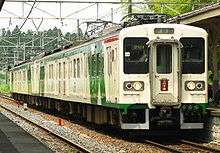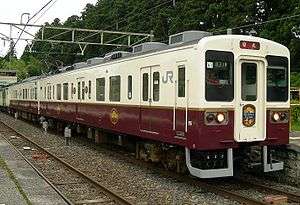107 series
| 107 series | |
|---|---|
|
107-0 series set in revised Nikko Line livery, June 2009 | |
| In service | 1988–Present |
| Manufacturer | JR East |
| Built at | Ōmiya, Ōi, Ōfuna, Niitsu, Nagano |
| Replaced | 165 series |
| Constructed | 1988–1991 |
| Number in service | 54 vehicles (27 sets)[1] |
| Formation | 2 cars per trainset |
| Operator(s) | JR East |
| Depot(s) | Takasaki[1] |
| Specifications | |
| Car body construction | Steel |
| Car length | 20,000 mm (65 ft 7 in) |
| Width | 2,800 mm (9 ft 2 in) |
| Doors | 3 pairs per side |
| Maximum speed | 100 km/h (60 mph)[2] |
| Traction system | Resistor control |
| Electric system(s) | 1,500 V DC |
| Current collection method | Overhead catenary |
| Safety system(s) | ATS-P[1] |
| Track gauge | 1,067 mm (3 ft 6 in) |
The 107 series (107系) is a DC electric multiple unit (EMU) train type operated on local services by East Japan Railway Company (JR East) in Japan since 1988. They were the first EMUs to be built by JR East following the splitting of the former Japanese National Railways (JNR).[3]
Variants
- 107-0 series: 2-car sets formerly used on Nikko Line services (until March 2013)
- 107-100 series: 2-car sets used on Ryomo Line, Agatsuma Line, Jōetsu Line, and Shinetsu Line services
107-0 series
Eight 2-car sets (sets N1 to N8) were allocated to Oyama Depot for use on Nikko Line local services.[1] The units entered service on 1 June 1988, and were originally painted in a livery designed by a Tochigi high school student, featuring large green "N" logos on a cream base. A new "retro" livery of brown and cream was introduced from March 2009, with the last train in original livery running until 17 January 2010.[3] The 107-0 series sets were withdrawn from service on the Nikko Line on 15 March 2013.[4]
-

107-0 series set in original Nikko Line livery, June 2008
-

Interior view, July 2010
Formation
- KuMoHa 107 (with two pantographs)
- KuHa 106 (with toilet)
107-100 series
Nineteen 2-car sets (R1 to R19) were delivered to Takasaki Depot between November 1988 and February 1991 for use on Ryomo Line, Agatsuma Line, Jōetsu Line, and Shinetsu Line local services. The livery is all-over cream with green and pink lining. Sets from R6 onwards have no door pocket windows.[1]
-
107-100 series set R2 at Yokokawa Station, April 2007
-
107-100 series set (with no door pocket windows) at Kuroiso Station, August 2009
-
Interior view of 107-100 series set
Formation
- KuMoHa 107 (with one pantograph)
- KuHa 106 (with toilet)
Replacement and withdrawal
The Nikko Line fleet was withdrawn and replaced by four refurbished 4-car 205 series EMUs from the start of the revised timetable on 16 March 2013.[4]
References
- 1 2 3 4 5 JR電車編成表 2009夏 [JR EMU Formations - Summer 2009]. Japan: JRR. June 2009. ISBN 978-4-330-06909-8.
- ↑ JR全車輌ハンドブック2009 (JR Rolling Stock Handbook 2009). Japan: Neko Publishing. 2009. ISBN 978-4-7770-0836-0.
- 1 2 Hobidas: 日光線107系0番代 従来デザイン車運行終了 (13 January 2010). Retrieved 13 January 2010. (Japanese)
- 1 2 日光線用107系が営業運転を終了 [Nikko Line 107 series withdrawn from service]. Japan Railfan Magazine Online (in Japanese). Japan: Koyusha Co., Ltd. 16 March 2013. Retrieved 1 April 2013.
External links
| Wikimedia Commons has media related to 107 series. |
- JR East 107 series (Japanese)

